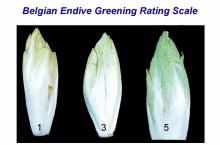Product Description
Indices de Maturité
Maturity is based on chicon size and compactness and varies according to cultivar and the quality of the tap root (amount of carbohydrate reserves). The firm heads are harvested by snapping from the root.
Quality is based on size, compactness, shape, and color. After trimming outer leaves, the chicons should be white with closed cream-yellow points and not have any torn leaves. Witloof chicory cultivars vary in flavor and bitterness (caused by sesquiterpene lactones). Chicons rapidly turn green if exposed to light and the flavor changes (see Special Considerations). Good quality chicons do not have any traces of green but are white with cream-yellow leaf edges.
Manipulation et stockage post-récolte
0°C (32°F) is required to optimize witloof chicory storage and life. A shelf-life of 21-28 days can be expected at this temperature. At 5°C (41°F) a shelf-life of about 14 days can be expected. Witloof chicory is usually room cooled after packing. Placing chicons on ice for retail display will cause discoloration.
Freezing Injury. Freeze damage weakens the leaves and can lead to more rapid bacterial decay. During storage, freeze damage can occur if chicons are stored at
Belgian endive chicons have moderate respiration rates:
| Temperature | 0°C (32°F) | 10°C (50°F) | 20°C (68°F) |
| ml CO2/kg·hr | 4-5 | 14-17 | 35-44 |
To calculate heat production, multiply ml CO2/kg·hr by 440 to get BTU/ton/day or by 122 to get kcal/metric ton-day.
Witloof chicory or Belgian endive is moderately sensitive to ethylene exposure. The main symptoms of ethylene injury are accelerated decay and discoloration of the leaf margins. Ethylene could also be expected to induce leaf abscission, but this effect may require a very long period at low storage temperatures.
>95%
Ethylene production rates of harvested chicons are <0.1, 0.2, and 0.7 µL/kg·hr at 0, 10 and 20°C (32, 50 and 68°F), respectively.
Some benefit to shelf-life can be obtained with low O2 (3-4%) and high CO2 to (4-5%) atmospheres at temperatures of 0-5°C (32-41°F). CA retards the development of browning on leaf edges. CO2 atmospheres also retard discoloration of the butt also. To control greening, extremely low O2 concentrations (<0.1%) are required.
Exposure to light causes the chicons to turn green and become unmarketable. Packaging in paper liners in unvented boxes ensures dark storage during distribution. However at retail, the chicons will turn green within a few hours at 10-15°C (50-59°F) of exposure to display lights. Therefore only a few should be removed from the box at a time to reduce exposure to light. Another option is to place the chicons in a plastic box with a lid that excludes light. If kept cold 0-5°C (32-41°F) it takes longer than 2 days for greening to occur.
Désordres
Internal Browning. The warm forcing conditions for witloof chicory production can cause browning of the chicon axis. This is thought to be due to a localized calcium deficiency in the rapidly developing head.
Physical Injury. Breakage of the outer leaf margins often occurs during harvest, trimming and packing and causes increased browning and increased susceptibility to bacterial decay.
Decay is not a common cause of postharvest losses of witloof chicory. However, bacterial rots caused by numerous bacteria (Erwinia, Pseudomonas and Xanthomonas spp.) can occur and result in a slimy breakdown of the infected tissue. Trimming outer leaves, rapid cooling and low storage temperature reduce development of bacterial rots. Sanitation during initial harvest, trimming and washing reduce bacterial decays.
References
References from scientifically validated sources will be added in the future.



